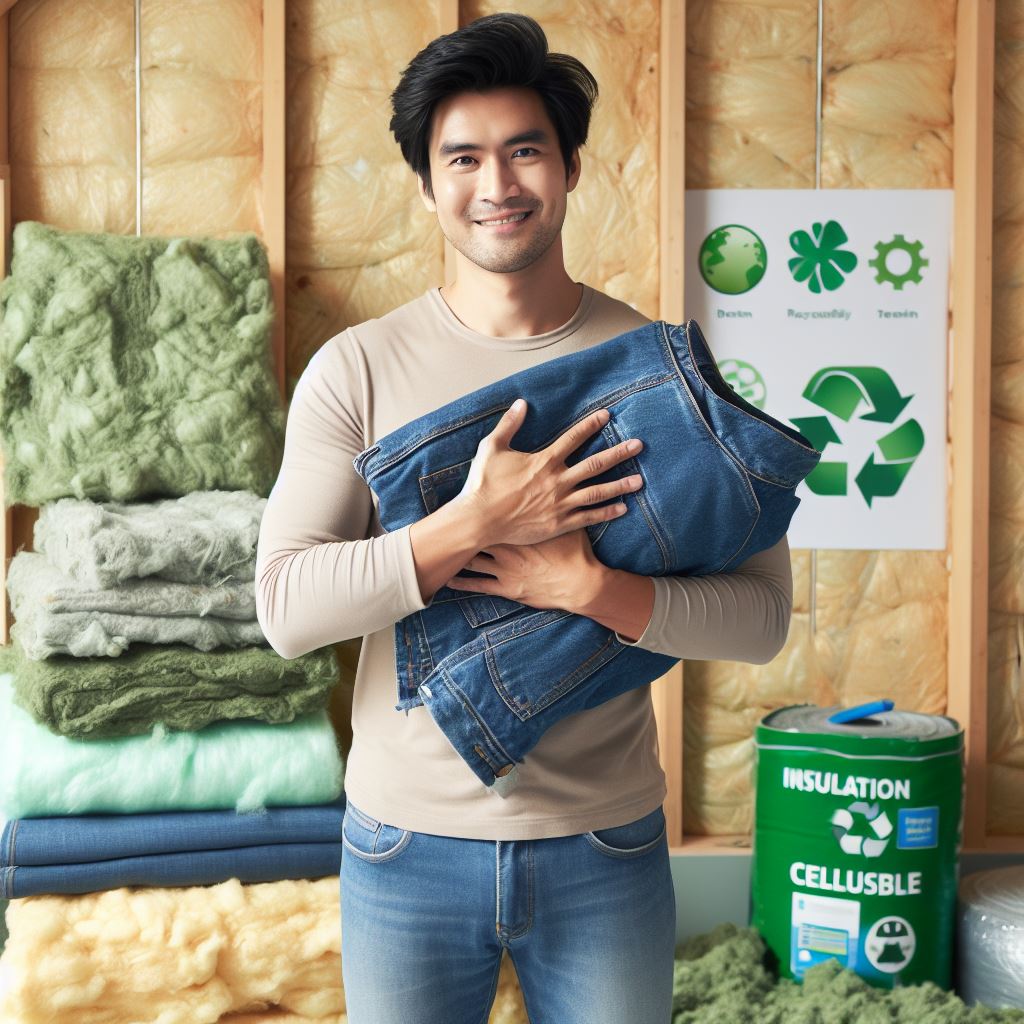Introduction
Eco Friendly Insulation Options for Homes: In today’s world, eco-friendly insulation for homes has become increasingly important.
With a rising demand for energy-efficient homes, people are looking for sustainable and eco-friendly options.
This post will provide an overview of the top 10 insulation options for homes that are both energy-efficient and environmentally friendly.
As we become more aware of the impact our homes have on the environment, it becomes crucial to choose insulation materials that are sustainable and eco-friendly.
Traditional insulation materials, such as fiberglass, can release harmful chemicals into the air and can take hundreds of years to decompose.
The increasing demand for energy-efficient homes has led to the development of innovative and eco-friendly insulation options.
These options not only provide excellent thermal insulation but also reduce energy consumption and carbon footprint.
The top 10 eco-friendly insulation options for homes include cellulose insulation, made from recycled materials such as newspapers and cardboard; sheep’s wool insulation, which is renewable and biodegradable; denim insulation, produced from recycled denim jeans; and cork insulation, made from the bark of cork oak trees.
Other eco-friendly options include soy insulation, which is derived from soybean oil, and hemp insulation, made from the fast-growing hemp plant.
Additionally, aerogel insulation, which is highly efficient and made from silica aerogels, and recycled plastic insulation produced from recycled plastic bottles are also popular choices.
Furthermore, straw bale insulation, which uses straw bales to provide excellent insulation properties, and earth insulation, which utilizes soil and clay as insulation materials, complete the top 10 eco-friendly options for homes.
In fact, the importance of eco-friendly insulation cannot be overstated.
With the increasing demand for energy-efficient homes, it is essential to choose sustainable and eco-friendly options that minimize harm to the environment.
By opting for these top 10 insulation options, homeowners can contribute to a greener and more sustainable future.
Fiberglass Insulation
Definition and Composition
Fiberglass insulation has long been a staple in home construction, renowned for its efficiency in regulating temperature.
Composed of tiny glass fibers, this insulation type is manufactured by weaving or spinning molten glass into thin fibers, forming a material that effectively traps heat.
The result is a lightweight, yet durable insulation solution that can be easily installed within walls, attics, and floors.
Eco-friendly Features
Fiberglass insulation, when produced with recycled glass content, exhibits notable eco-friendly characteristics.
Recycling post-consumer glass reduces the demand for raw materials and diminishes the environmental impact of traditional manufacturing processes.
Opting for fiberglass insulation made from recycled glass contributes to waste reduction, embodying a sustainable approach in insulation choices.
Benefits and Drawbacks
The benefits of fiberglass insulation extend beyond its thermal efficiency.
It is resistant to mold, mildew, and pests, promoting a healthier indoor environment.
Fiberglass insulation is also non-combustible, enhancing fire safety within homes.
However, drawbacks include potential skin irritation during installation, requiring proper protective gear.
Additionally, fiberglass insulation can settle over time, affecting its performance, and may not be as effective in damp conditions.
Cost Considerations
Fiberglass insulation is known for its cost-effectiveness.
It generally falls on the lower end of the price spectrum compared to other insulation materials.
The initial investment is affordable, making it an attractive option for budget-conscious homeowners.
Moreover, the long-term energy savings associated with fiberglass insulation can offset the initial cost, providing a compelling economic incentive.
In short, fiberglass insulation is a versatile and widely-used option with significant eco-friendly potential.
By opting for varieties with recycled content, homeowners can contribute to sustainable practices while enjoying the numerous benefits this insulation type offers.
Balancing cost considerations with environmental consciousness, fiberglass insulation stands as a viable choice in creating energy-efficient and eco-friendly homes.
Read: Creative DIY Shelving Ideas for Every Room
Cellulose Insulation: A Sustainable Home Solution
Sustainable living begins with conscious choices, especially when it comes to insulating our homes.
In the realm of eco-friendly insulation, Cellulose stands out as a top contender.
Let’s delve into its definition, composition, eco-friendly features, benefits, drawbacks, and the cost considerations that make it a noteworthy choice for environmentally conscious homeowners.
Definition and Composition
Cellulose insulation is derived from recycled paper products, primarily newspapers.
The paper is treated with non-toxic flame retardants, providing a safe and efficient insulating material.
This eco-friendly solution effectively repurposes waste, contributing to a circular economy.
Eco-Friendly Features
One of Cellulose’s most significant eco-friendly features is its recycled content.
By diverting paper waste from landfills, it reduces the environmental impact of traditional insulation materials.
Additionally, the production process requires less energy compared to manufacturing fiberglass or foam insulation.
Cellulose insulation also boasts impressive thermal performance, effectively regulating indoor temperatures.
This can result in lower energy consumption for heating or cooling, further reducing a home’s carbon footprint.
Benefits and Drawbacks
Cellulose insulation excels in both thermal and acoustical insulation, creating a comfortable and quiet living environment.
It is also resistant to pests and mold, contributing to healthier indoor air quality.
However, it’s essential to consider potential drawbacks, such as settling over time, which may affect its long-term performance.
Cost Considerations
While Cellulose insulation may have a higher upfront cost than traditional options, the long-term benefits often outweigh the initial investment.
Energy savings, improved indoor air quality, and the positive environmental impact make it a cost-effective choice in the grand scheme of homeownership.
In essence, Cellulose insulation is a prime example of a sustainable, eco-friendly solution for homes.
Its recycled composition, energy efficiency, and long-term benefits make it a smart choice for those committed to reducing their ecological footprint.
As we strive for greener living, embracing options like Cellulose insulation paves the way for a more sustainable future.
Read: DIY Home Security Upgrades for Safety
Recycled Cotton Insulation
As the world grapples with the pressing need for sustainable living practices, the quest for eco-friendly insulation options has gained momentum.
Among the top contenders is Recycled Cotton Insulation, an innovative solution that marries effectiveness with environmental consciousness.
Definition and Composition
Recycled Cotton Insulation is crafted from post-consumer recycled denim, giving a second life to old jeans and denim scraps.
The material is transformed through a process that involves breaking down the denim into fibers, which are then treated for fire resistance.
The result is a versatile insulation material that retains the comfort and durability associated with denim.
Eco-friendly Features
One of the standout features of Recycled Cotton Insulation is its minimal environmental impact.
By repurposing discarded denim, this insulation option significantly reduces the demand for new raw materials, curbing the strain on natural resources.
Additionally, the manufacturing process emits fewer greenhouse gases compared to traditional insulation methods, contributing to a lower carbon footprint.
Benefits and Drawbacks
Recycled Cotton Insulation boasts commendable thermal performance, effectively regulating indoor temperatures and reducing energy consumption.
Its natural fibers also make it a breathable option, promoting healthier indoor air quality.
However, it’s essential to note that while resistant to mold and pests, this insulation may be more susceptible to moisture than some alternatives.
Proper installation and moisture control are crucial for maximizing its effectiveness.
Cost Considerations
While Recycled Cotton Insulation may seem more expensive upfront than conventional options, its long-term benefits can outweigh the initial investment.
Reduced energy bills, improved indoor air quality, and the satisfaction of contributing to a circular economy are compelling reasons to consider this eco-friendly insulation.
In a nutshell, Recycled Cotton Insulation stands out as a beacon of sustainability in the realm of home insulation.
Its unique composition, eco-friendly features, and long-term benefits position it as a frontrunner for environmentally conscious homeowners seeking to make a positive impact on both their comfort and the planet.
Read: Beginner’s Guide to DIY Plumbing Fixes
Sheep’s Wool Insulation
Definition and Composition
Sheep’s wool insulation is a sustainable and eco-friendly option gaining popularity in the realm of home insulation.
Sourced from the fleece of sheep, this insulation material offers a natural and renewable alternative to conventional options.
The wool is carefully processed to create insulation batts or rolls that can be easily installed in various parts of a home.
Eco-friendly Features
Sheep’s wool insulation stands out for its eco-friendly characteristics.
First and foremost, it is a renewable resource, as sheep can be shorn annually without harm.
The production process has a low environmental impact, and the insulation itself is biodegradable, reducing concerns about long-term waste.
Additionally, sheep’s wool acts as a carbon sink, meaning it absorbs carbon dioxide from the atmosphere during the growth of the wool, further contributing to its environmental friendliness.
Benefits and Drawbacks
Sheep’s wool insulation offers numerous benefits for homeowners.
It boasts excellent thermal performance, providing effective insulation against both cold and heat.
The material also has inherent moisture-wicking properties, helping regulate indoor humidity and preventing mold growth.
Furthermore, sheep’s wool insulation is naturally fire-resistant, eliminating the need for additional chemical treatments.
However, drawbacks exist, such as potential allergenic reactions for those sensitive to wool.
Additionally, it may compress over time, reducing its insulation effectiveness.
Proper installation and maintenance are crucial to mitigate these issues.
Cost Considerations
While sheep’s wool insulation may have a higher upfront cost compared to some traditional materials, its long-term benefits often outweigh the initial investment.
Energy savings due to its superior thermal performance can lead to reduced heating and cooling expenses over time.
Additionally, some governments offer incentives or rebates for using eco-friendly insulation materials, helping offset the cost.
Basically, sheep’s wool insulation stands as a top eco-friendly choice for homes.
Its natural composition, sustainable sourcing, and impressive insulation properties make it a compelling option for environmentally conscious homeowners looking to enhance both comfort and sustainability in their living spaces.
Read: Ultimate Guide to DIY Wall Texturing

Polystyrene Insulation
Polystyrene insulation is one of the top eco-friendly options for insulating homes.
Made from petroleum-based plastic, this type of rigid foam offers several benefits and considerations.
Let’s explore its definition, composition, eco-friendly features, benefits, drawbacks, and cost considerations.
Definition and composition
Polystyrene insulation is a type of rigid foam commonly used for insulation purposes.
It is made from a petroleum-based plastic called polystyrene, which is a lightweight and durable material.
There are two common forms of polystyrene insulation: expanded polystyrene (EPS) and extruded polystyrene (XPS).
EPS insulation is produced by expanding beads of polystyrene, while XPS insulation is made by extruding molten polystyrene through a die.
Eco-friendly features
From an eco-friendly perspective, polystyrene insulation has some positive features.
Firstly, it is recyclable, meaning it can be transformed into new products instead of ending up in landfills.
This recycling process reduces waste and conserves resources.
Additionally, EPS insulation has a low impact on ozone depletion and global warming potential. Choosing EPS insulation can help mitigate the negative environmental impact.
Furthermore, some companies offer EPS insulation made from recycled materials, making it even more sustainable.
By utilizing recycled polystyrene, the overall environmental footprint of the insulation is reduced.
This option appeals to homeowners who prioritize using environmentally friendly materials for their homes.
Benefits and drawbacks
Polystyrene insulation offers various benefits and drawbacks.
First and foremost, it has a high R-value, meaning it provides excellent thermal resistance.
This enhances energy efficiency and reduces heating and cooling costs.
Additionally, polystyrene insulation is resistant to moisture, mold, and pests.
This makes it suitable for various climates and ensures long-lasting performance.
On the other hand, one significant drawback of polystyrene insulation is its lack of biodegradability.
Unlike some natural insulation materials, polystyrene does not break down over time.
If not properly reused or recycled, it can contribute to environmental pollution.
Another concern is the release of toxic fumes when polystyrene is burned.
Safe disposal is crucial to prevent any harmful effects on the environment and human health.
Cost considerations
In terms of cost considerations, polystyrene insulation is relatively affordable compared to other eco-friendly alternatives.
The cost may vary depending on factors such as the type of insulation (EPS or XPS), thickness, and specific brand.
While the insulation itself may be economical, professional installation can add to the overall cost.
Hiring experts ensures proper installation for optimal energy efficiency and performance.
All in all, polystyrene insulation offers several eco-friendly features, benefits, and drawbacks. It is a recyclable and energy-efficient option with a high thermal resistance.
However, its lack of biodegradability and potential toxicity when burned should be considered.
Homeowners looking for budget-friendly and sustainable insulation may find polystyrene to be a suitable choice.
By weighing the environmental impact and cost considerations, individuals can make an informed decision when insulating their homes.
Natural Fiber Insulation
As sustainability takes center stage in home construction, natural fiber insulation emerges as a compelling eco-friendly option.
This section delves into the definition, composition, eco-friendly features, benefits, drawbacks, and cost considerations of this innovative insulation choice.
Definition and Composition
Natural fiber insulation is derived from renewable plant or animal sources, offering an environmentally conscious alternative to traditional insulating materials.
Common materials include cotton, wool, hemp, and straw.
These fibers are processed to create dense batts or loose-fill insulation that effectively regulates indoor temperatures.
Eco-friendly Features
The hallmark of natural fiber insulation lies in its minimal environmental impact.
Sourced from rapidly renewable materials, these insulations boast a significantly lower carbon footprint compared to synthetic counterparts.
The production processes often involve fewer chemicals and energy, contributing to a greener construction cycle.
Additionally, natural fibers are biodegradable, ensuring a reduced environmental burden at the end of their lifespan.
Benefits and Drawbacks
Natural fiber insulation offers notable benefits such as excellent thermal performance, moisture absorption, and sound insulation.
These materials are breathable, preventing condensation and mold growth.
However, it’s crucial to consider potential drawbacks.
Some natural fibers may be susceptible to pests, requiring additional treatments.
Moreover, certain types may compress over time, impacting long-term effectiveness.
Cost Considerations
While natural fiber insulation may seem pricier upfront, the long-term cost-effectiveness becomes evident.
Energy savings due to enhanced thermal performance contribute to reduced heating and cooling expenses.
Additionally, government incentives and rebates may be available, making the initial investment more appealing.
Therefore, natural fiber insulation represents a sustainable choice for eco-conscious homeowners.
The inherent benefits, coupled with careful consideration of drawbacks and cost factors, position it as a frontrunner in the quest for energy-efficient, environmentally friendly housing solutions.
As the demand for green building practices grows, natural fiber insulation stands poised to reshape the landscape of home insulation.
Aerogel Insulation
Definition and Composition
Aerogel insulation, often dubbed “frozen smoke,” is a cutting-edge material with a composition that defies conventional insulation norms.
Comprising a gel that replaces its liquid component with gas, aerogel is a solid yet incredibly lightweight substance.
Silica aerogel, one of the most common variants, is derived from silica gel, offering a unique blend of low density and superior thermal insulation properties.
Eco-Friendly Features
Aerogel insulation stands out in the realm of eco-friendly building materials.
Its production process involves minimal environmental impact, as it requires fewer raw materials compared to traditional insulation.
Additionally, aerogel’s longevity contributes to sustainability, as it maintains its effectiveness over an extended period, reducing the need for frequent replacements and minimizing waste.
Benefits and Drawbacks
The benefits of aerogel insulation extend beyond its eco-friendly attributes.
Remarkably efficient in terms of thermal conductivity, aerogel provides superior insulation with minimal thickness.
This thin profile allows for more design flexibility in construction while maintaining optimal energy efficiency.
Furthermore, aerogel is water-resistant, preventing mold growth and ensuring a healthier indoor environment.
However, like any material, aerogel insulation has its drawbacks.
One primary concern is its initial cost, which tends to be higher than traditional insulation options.
Additionally, while aerogel is highly effective in dry conditions, its performance may decrease in wet or humid environments, making it crucial to assess the climate of the location where it will be installed.
Cost Considerations
The cost of aerogel insulation can be a potential deterrent for some homeowners.
However, it’s essential to consider the long-term savings it offers through reduced energy consumption.
The initial investment in aerogel insulation pays off over time as lower utility bills become evident.
Essentially, aerogel insulation emerges as a forward-thinking choice for environmentally conscious homeowners.
Its unique composition, coupled with eco-friendly production methods, positions it as a sustainable solution for efficient insulation.
While the initial cost may be a factor, the long-term benefits and positive environmental impact make aerogel insulation a compelling choice for the eco-minded homeowner.
Soy-Based Foam Insulation
In the quest for sustainable living, homeowners are increasingly turning to eco-friendly insulation options to reduce their carbon footprint.
Among the top choices stands out Soy-Based Foam Insulation – a revolutionary solution that combines performance with environmental consciousness.
Definition and Composition
Soy-Based Foam Insulation is a cutting-edge insulation material derived from renewable soybean oil.
This bio-based alternative to traditional insulation materials like fiberglass or foam is known for its versatility and efficiency.
Its composition involves a mixture of soybean oil, polyols, and other natural additives, creating a foam that expands and hardens to form a durable insulation layer.
Eco-friendly Features
This insulation option boasts a plethora of eco-friendly features.
Firstly, the primary raw material, soybean oil, is a renewable resource that significantly reduces the dependency on fossil fuels.
Soy-Based Foam Insulation also has a lower carbon footprint compared to conventional insulating materials, contributing to a more sustainable construction industry.
Furthermore, its manufacturing process generates minimal waste, aligning with the principles of a circular economy.
Benefits and Drawbacks
Soy-Based Foam Insulation comes with a myriad of benefits.
Its superior thermal insulation properties ensure energy efficiency by keeping homes warmer in winter and cooler in summer.
Additionally, it provides excellent soundproofing, enhancing the overall comfort of living spaces.
However, like any material, it has some drawbacks.
Some individuals may be sensitive to the soy-based components, necessitating careful consideration for those with allergies.
Cost Considerations
While Soy-Based Foam Insulation may have a higher initial cost compared to traditional options, the long-term benefits often outweigh the investment.
The energy savings realized over time contribute to lower utility bills, making it a financially prudent choice in the grand scheme of homeownership.
Ultimately, Soy-Based Foam Insulation emerges as a game-changer in the realm of eco-friendly insulation.
Its composition, eco-friendly features, and numerous benefits make it a sustainable choice for homeowners looking to make a positive impact on the environment while enjoying the comforts of an energy-efficient home.
Hempcrete Insulation
Definition and Composition
Hempcrete insulation, denoted as in the realm of eco-friendly insulation options, is gaining popularity for its sustainable and environmentally conscious composition.
Derived from the inner woody fibers of the hemp plant, hempcrete is a mixture of hemp hurds, lime, and water.
The combination creates a versatile and sturdy material with remarkable insulation properties.
Eco-friendly Features
Hempcrete stands out as an eco-friendly insulation option due to its minimal environmental impact.
Hemp plants are fast-growing and require minimal pesticides, making them a renewable resource.
Additionally, the cultivation of hemp aids in carbon sequestration, contributing to a reduction in greenhouse gas emissions.
The lime component in hempcrete absorbs carbon dioxide during its curing process, further enhancing its eco-friendly profile.
This makes hempcrete a carbon-negative material, actively mitigating its own carbon footprint.
Benefits and Drawbacks
The benefits of hempcrete insulation are manifold.
Its excellent thermal performance regulates indoor temperatures efficiently, reducing the need for constant heating or cooling.
Hempcrete is also resistant to mold, pests, and fire, ensuring a safe and healthy living environment.
Moreover, it promotes a breathable structure, preventing moisture-related issues.
However, drawbacks include a longer curing time compared to traditional insulation materials.
This might extend construction timelines.
Additionally, the availability of hempcrete may vary regionally, impacting its accessibility.
Cost Considerations
While hempcrete may have a higher upfront cost than conventional insulation materials, its long-term benefits often outweigh the initial investment.
The energy savings resulting from its exceptional thermal properties can lead to reduced utility bills over time.
As awareness and demand for sustainable materials increase, the cost of hempcrete may become more competitive.
To conclude, VX. Hempcrete insulation emerges as a frontrunner in eco-friendly options for homes.
Its composition, eco-friendly features, and long-term benefits position it as a promising choice for those prioritizing sustainability in their homes.
Though considerations such as curing time and availability exist, the positive environmental impact makes hempcrete a compelling option in the quest for eco-conscious living.
Cork Insulation
Definition and Composition
Cork insulation, derived from the bark of cork oak trees, stands out as an eco-friendly insulation option.
The material is harvested without harming the trees, making it a sustainable and renewable resource.
The composition of cork insulation includes the outer bark of cork oak, which naturally regenerates every 9-12 years, ensuring minimal environmental impact.
Its cellular structure is composed of millions of air-filled pockets, providing excellent thermal insulation properties.
Eco-friendly Features
Cork insulation boasts several eco-friendly features.
Its production involves minimal energy consumption, and the harvesting process supports biodiversity by preserving cork oak habitats.
As a natural material, cork is biodegradable and does not release harmful chemicals into the environment.
Additionally, the insulation’s thermal resistance contributes to energy efficiency, reducing the overall carbon footprint of a home.
Benefits and Drawbacks
The benefits of cork insulation extend beyond its eco-friendly nature.
It exhibits excellent thermal and acoustic insulation properties, effectively regulating indoor temperatures and minimizing external noise.
Cork insulation is also resistant to mold, mildew, and pests, contributing to a healthier indoor environment.
However, it’s essential to consider potential drawbacks, such as its vulnerability to compression over time and a moderate upfront cost.
Cost Considerations
While cork insulation may have a slightly higher initial cost compared to some traditional options, its long-term benefits often outweigh the expense.
The energy savings resulting from its exceptional insulation properties contribute to lower utility bills, providing a return on investment over time.
Homeowners interested in sustainable living and seeking to minimize their ecological impact will find the additional cost worthwhile for the environmental benefits and the overall comfort it brings to their homes.
In closing, cork insulation emerges as a top eco-friendly choice for those looking to enhance their homes while prioritizing sustainability.
Its unique composition, eco-friendly features, and various benefits make it a viable option for environmentally conscious homeowners.
Despite some considerations, the long-term advantages and positive environmental impact position cork insulation as a valuable investment in creating a greener, more energy-efficient home.
Conclusion
The Top 10 Eco-Friendly Insulation Options
As we journey through the realms of sustainable living, choosing eco-friendly insulation for our homes emerges as a pivotal step towards a greener and healthier future.
Let’s revisit the top 10 insulation options that not only enhance energy efficiency but also contribute to environmental well-being.
- Cellulose Insulation: Crafted from recycled paper, this option offers excellent thermal performance while reducing landfill waste.
- Recycled Cotton Insulation: Old denim finds new life as insulation, providing a safe and effective alternative to traditional materials.
- Sheep’s Wool Insulation: A natural and renewable resource, sheep’s wool insulation is not only effective but also biodegradable.
- Hemp Insulation: Derived from the hemp plant, this eco-friendly option requires minimal processing and has a low environmental impact.
- Cork Insulation: Harvested from the bark of cork oak trees, this sustainable material is not only a fantastic insulator but also supports biodiversity.
- Aerogel Insulation: Despite its high-tech nature, aerogel insulation is eco-friendly, as it is composed mostly of air and silica aerogels, which have minimal environmental impact.
- Recycled Fiberglass Insulation: By repurposing glass, this insulation option minimizes the need for new raw materials and decreases energy consumption during production.
- Wool Insulation: Whether sourced from sheep or other animals, wool insulation is a natural and biodegradable option with impressive thermal properties.
- Straw Bales: An unconventional yet effective choice, straw bales offer excellent insulation and can be locally sourced, reducing transportation emissions.
- Mycelium Insulation: Harnessing the power of fungi, mycelium insulation is not only biodegradable but also offers a sustainable alternative to traditional insulation materials.
As we stand at the crossroads of ecological responsibility, the decision to opt for eco-friendly insulation becomes more critical than ever.
Beyond the immediate benefits of energy efficiency and cost savings, choosing sustainable insulation materials aligns with our collective responsibility to preserve the environment for future generations.




